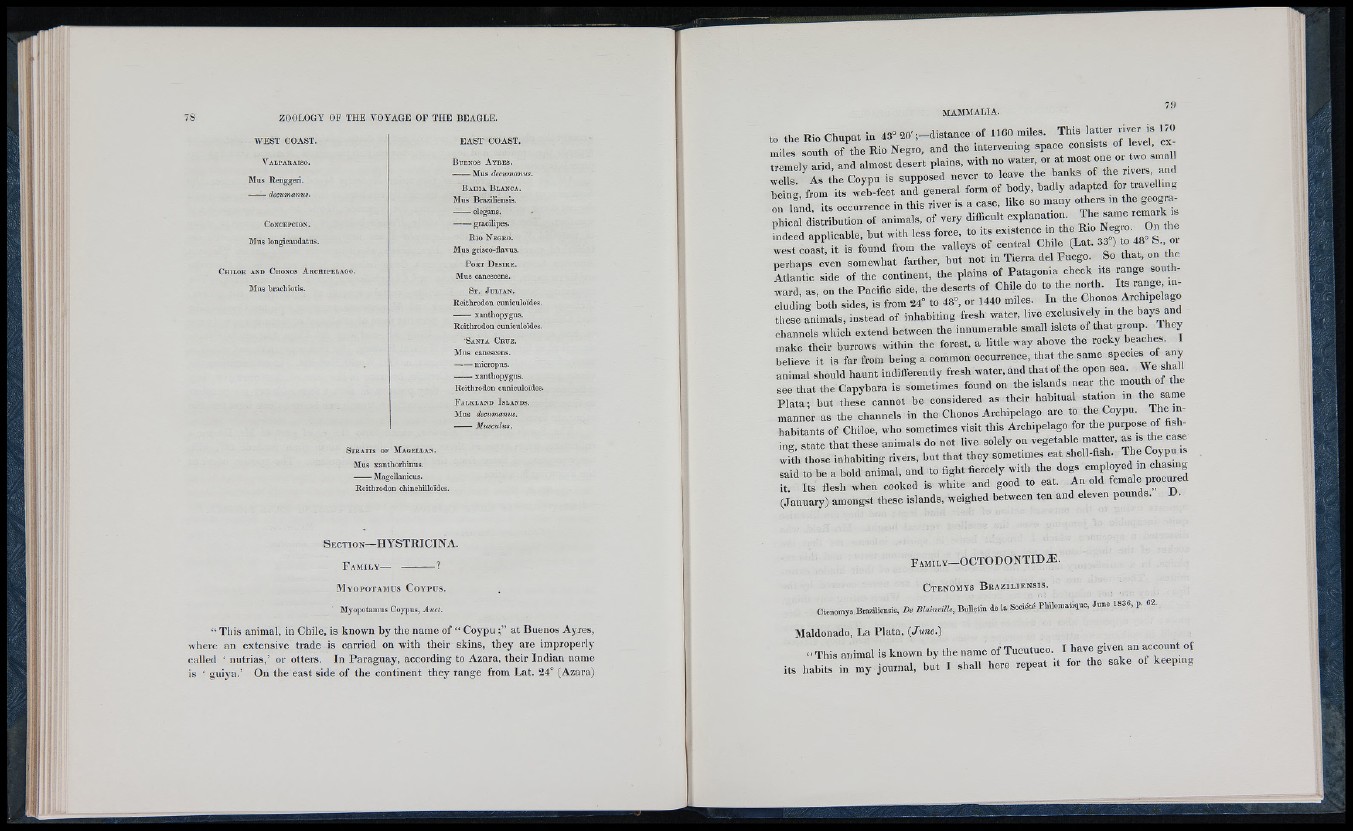
W E ST COAST.
V a l p a r a i s o .
Mus ;
decumanus.
C o n c ep c io n .
Mus longicaudatus.
C h ilo e a n d C h o n o s A r c h ip e la g o .
5Ius brachiotis.
EA ST COAST.
B u en o s A y r e s .
Mus decumamis.
B a h i a B la n c a .
Mus Braziliensis.
gracilipes.
R io N e g r o .
JIu s griseo-flavus.
P o r t D e s ir e .
Mus canescens.
S t . J u l i a n .
Reithrodon cuniculo'ides.
xanthopygus.
Reithrodon cuniculoides.
Sa n t a C r u z .
Mus canescens.
micropiis.
xanthopygus.
Reithrodon cuniculoides.
F a l k l a n d I s la n d s .
Mus decumanus.
Musculus.
S t r a i t s o f M a g e lla n .
Mus xanthorhinus.
Magellanicus.
Reithrodon chinchilloides.
S ection—HYSTRICINA.
F a m il y —
M y o p o t a m u s C o y p u s .
Myopotainus Coypus, Auct.
“ Tliis animal, in Chile, is known by the name of “ Coypu at Buenos Ayres,
where an extensive trade is carried on with their skins, they are improperly
called ‘ nutrias,’ or otters. In Paraguay, according to Azara, their Indian name
is ‘ guiya.’ On the east side of the continent they range from Lat. 24° (Azara)
to the Rio Chupat in 43° 20';-distance of U 60 miles. This
on l a ; r u s occurrence in this river is a case, like so many others in the geographical
distribution of animals, of very difficult explanation -
Indeed applicable, hut with less force, to its west coast, it is found from the valleys of central Chile‘ (TL at. 333^ °)7 too 4488° SS . o!
perhaps even somewhat farther, hut not m Tierra del Fuego. So * a t, on tlm
Atlantic side of the continent, the plains of Patagonia check its ' “ ge on h-
ward, as, on the Pacific side, the deserts of Chile do to the north. Its « n g e including
both sides, is from 24° to 48°, or 1440 miles. In
these animals, instead of inhabiting fresh water,
channels which extend between the innumerable small islets of that S™“P'
make their burrows within the forest, a little way above the rocky bea®hj.
believe it is far from being a common occurrence, that the same ^
animal should haunt indifferently fresh water, and that of the open sea. We shall
see that the Capybara is sometimes found on the islands near the mouth of the
Plata; but Z o cannot be considered as their habitual station in the same
manner as the channels in the Chonos Archipelago are to the Coypu. The inhabitants
of Chiloe, who sometimes visit this Archipelago for the
ing, state that these animals do not live solely on vegetable matter, “ the case
with those inhabiting rivers, hut that they sometimes eat shell-fish. The CoyP®
said to be a bold animal, and to fight fiercely with the dogs ^
it. Its flesh when cooked is white and good to eat. An old female procuied
(January) amongst these islands, weighed between ten and eleven pounds. U.
F amily-O C T O D O N T IDÆ .
C t e n o m y s B r a z i l i e n s i s .
Ctenomys B raÆ n sis, D . BM n zille, B ullelm de la Société P U to a tiq iie . June 1836, p. 62.
Maldonado, La Plata, (June.)
" This animal is known by the name of Tucutuco. I have given an account of
its habits in my journal, hut I shall here repeat it for the sake of keepi g
I I
i .
A